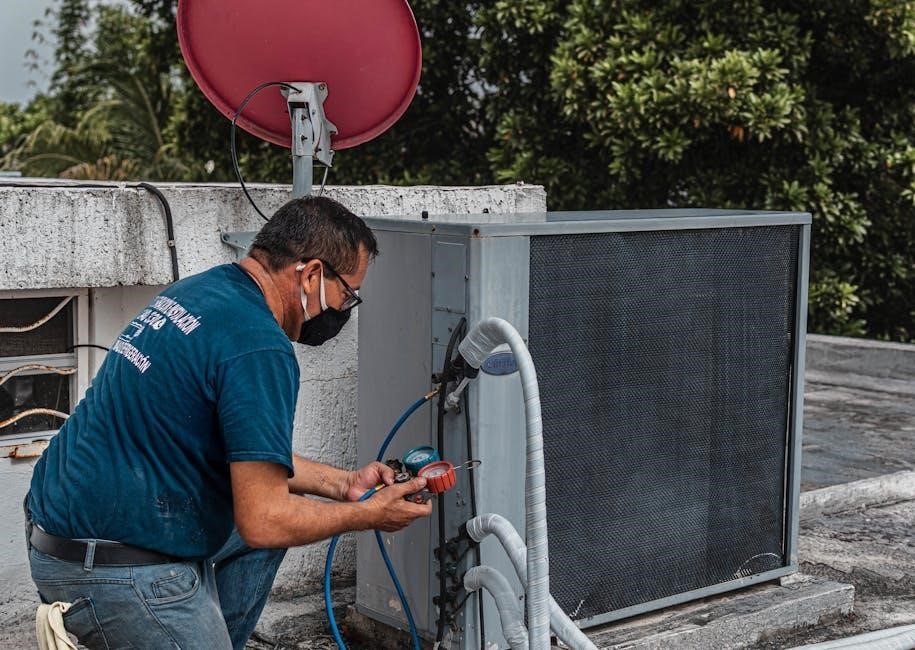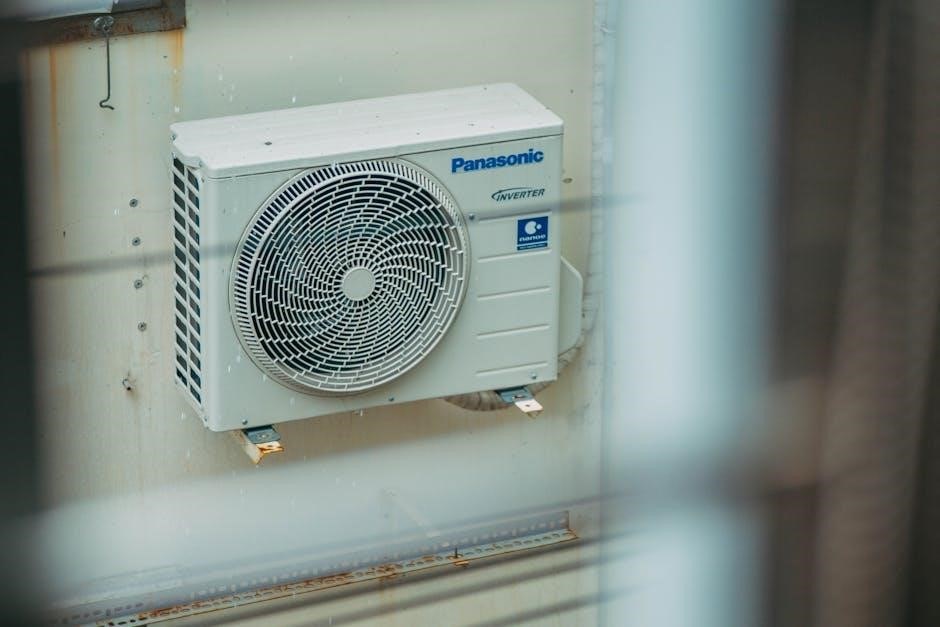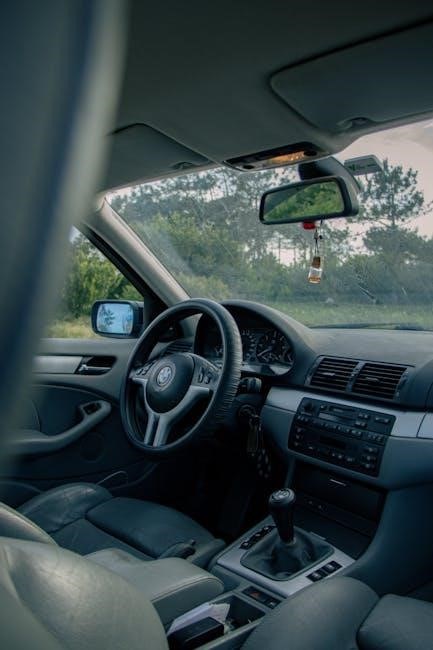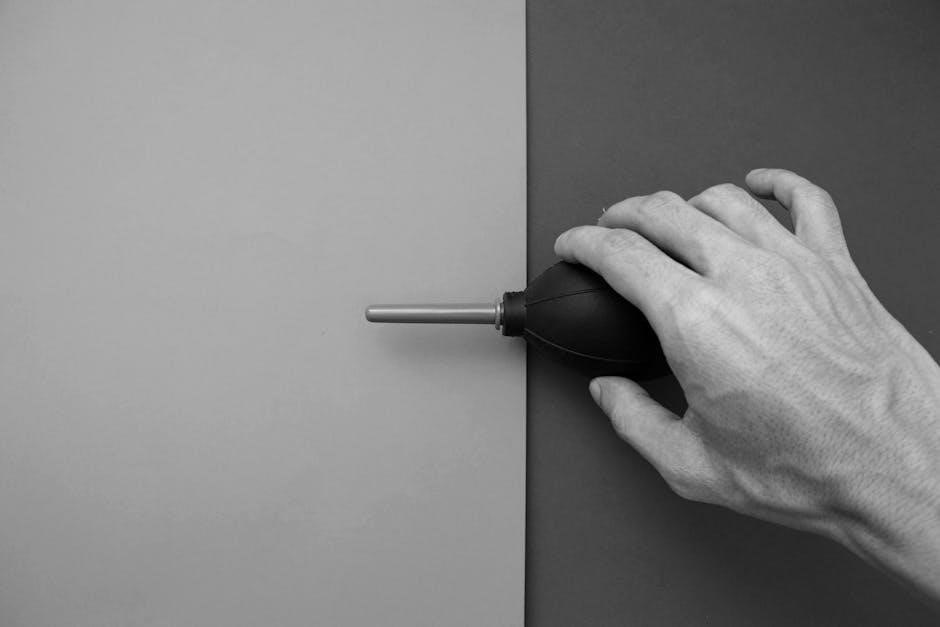Welcome to the Panasonic Air Conditioner User Manual! This guide provides essential information for safe installation, operation, and maintenance of your air conditioner. Ensure optimal performance and energy efficiency by following the instructions carefully.
1.1 Overview of the Panasonic Air Conditioner
The Panasonic Air Conditioner is a high-quality appliance designed to provide efficient cooling and comfort in various environments. It features advanced inverter technology, which ensures consistent performance while minimizing energy consumption. The unit is built with durable materials and incorporates smart operation capabilities, allowing seamless integration with modern smart home systems. Its sleek design and quiet operation make it suitable for both residential and commercial spaces. The air conditioner is equipped with multiple operating modes, including cooling, heating, and fan modes, to cater to different climate needs. Additionally, it includes a user-friendly remote control and an intuitive interface for easy adjustments. Panasonic air conditioners are known for their reliability and energy efficiency, making them a popular choice for homeowners seeking a balance between performance and cost-effectiveness.
1.2 Importance of Reading the User Manual
Reading the Panasonic Air Conditioner User Manual is essential for safe and efficient operation. It provides critical information on installation, maintenance, and troubleshooting, ensuring optimal performance and longevity of the unit. The manual outlines safety precautions, such as avoiding corrosion risks and proper electrical connections, to prevent accidents and damage. By understanding the operating modes, temperature settings, and energy-saving features, users can maximize comfort while minimizing energy consumption. Additionally, the manual helps users identify common issues and error codes, enabling quick resolutions. Adhering to the guidelines ensures compliance with local electrical codes and warranty conditions. Taking the time to read and follow the manual guarantees a seamless and enjoyable experience with your Panasonic Air Conditioner.
Safety Precautions
Ensure safe operation by following guidelines to protect users and the unit. Avoid electrical hazards, corrosion risks, and improper installations. Consult professionals for compliance with local codes and proper grounding.
2.1 General Safety Guidelines
Adhering to general safety guidelines is crucial for the safe operation of your Panasonic air conditioner. Always ensure the unit is installed in a well-ventilated area, away from direct sunlight and heat sources. Avoid exposing the outdoor unit to salty seawater or corrosive substances, as this can damage the system. Proper installation by a qualified technician is essential to prevent electrical hazards and ensure compliance with local safety standards. Never attempt to modify or repair the unit yourself, as this can lead to serious safety risks. Regularly inspect the power cord and plug for damage, and keep the unit out of reach of children. Failure to follow these guidelines may result in damage to the air conditioner or pose a risk to user safety.
2.2 Electrical Safety Considerations
Ensuring electrical safety is paramount when installing and operating your Panasonic air conditioner. All wiring must comply with local electrical codes, and the unit must be properly grounded using a ground wire or through the supply wiring. Only a qualified electrician should perform the wiring to avoid potential hazards; Never attempt to modify or tamper with the electrical components, as this can lead to serious risks, including electric shock or fire. Always switch off the outdoor unit before servicing to protect the compressor. Regularly inspect the power cord and plug for damage, and replace them if necessary. Proper electrical connections ensure safe and efficient operation of your air conditioner, safeguarding both the unit and its users.
2.3 Avoiding Corrosion Risks
To prevent corrosion and ensure longevity, avoid installing the outdoor unit in areas exposed to salty seawater or high humidity. Regularly clean the unit, especially the condenser coils, to remove dirt and moisture that can cause rust. Apply a corrosion-resistant coating if necessary, especially in coastal regions. Inspect the unit for signs of rust or damage during maintenance and address them promptly. Proper drainage is crucial to prevent water accumulation, which can accelerate corrosion. Ensure the unit is installed on a stable, level surface to avoid pooling water. By following these guidelines, you can protect your Panasonic air conditioner from corrosion and maintain its performance over time.

Installation Requirements
Proper installation ensures optimal performance and safety. Ensure compliance with local electrical codes, proper grounding, and avoid corrosive environments. Hire a qualified electrician for wiring and connections.
3.1 Indoor Unit Installation
Proper installation of the indoor unit is crucial for efficient operation. Ensure the unit is placed on a firm, level surface, away from direct sunlight and heat sources. Avoid installing in areas exposed to salty seawater to prevent corrosion. The unit should be positioned to allow adequate airflow and proper drainage. Follow local electrical codes and ensure the unit is properly grounded. Hire a qualified electrician for wiring to avoid safety hazards. Keep the unit away from flammable materials and ensure all connections are secure. Regularly inspect the installation for any signs of wear or damage. Proper installation ensures optimal performance, energy efficiency, and safety. Always refer to the manual for specific installation requirements.
3.2 Outdoor Unit Installation
Proper installation of the outdoor unit is essential for efficient cooling and system longevity. Place the unit on a firm, level surface, ensuring good airflow and drainage. Avoid areas exposed to salty seawater to prevent corrosion. The unit should be installed in a well-ventilated location, away from direct sunlight and heat sources. Ensure all electrical connections are made by a qualified electrician, following local codes. Proper grounding is crucial for safety and performance. Keep the unit away from flammable materials and ensure secure connections; Regularly inspect the installation for signs of wear or damage. Proper installation ensures optimal performance, energy efficiency, and safety. Always refer to the manual for specific installation requirements.
3.3 Wiring and Electrical Connections
Proper wiring and electrical connections are critical for safe and efficient operation of your Panasonic air conditioner. All wiring must comply with local electrical codes and be performed by a licensed electrician. Ensure the unit is properly grounded using a ground wire or through the supply wiring to prevent electrical hazards. Avoid using damaged or inappropriate cables, as this can lead to system malfunctions or safety risks. Switch off the outdoor unit before servicing to protect the compressor. The AVS (Active Voltage Stabilizer) indicator will illuminate during this process. Always follow the manufacturer’s guidelines for electrical connections to ensure reliability and performance. Proper wiring ensures optimal functionality, safety, and energy efficiency of your air conditioner.
3.4 Proper Grounding of the Unit
Proper grounding of your Panasonic air conditioner is essential for safety and optimal performance. Grounding ensures protection against electrical shocks and prevents damage to the unit. Use a ground wire or ensure proper grounding through the supply wiring, as specified in local electrical codes. Consult a qualified electrician to verify the grounding system meets safety standards. Improper grounding can lead to electrical hazards, malfunctions, or component damage. Regularly inspect the grounding system to avoid corrosion, especially in coastal areas where salty air may accelerate wear. Proper grounding not only enhances safety but also ensures efficient operation and protects the unit from voltage fluctuations. Always follow the manufacturer’s guidelines for grounding to maintain reliability and performance.

Operating Instructions
Learn how to operate your Panasonic air conditioner efficiently. This section covers starting the unit, using the remote control, and understanding modes for optimal cooling and comfort.
4.1 Starting the Air Conditioner
To start your Panasonic air conditioner, ensure the unit is properly installed and grounded. Press the power button on the remote control or the unit itself. Select your desired mode using the remote. For optimal performance, set the temperature between 17°C and 30°C. If the outdoor unit is off, switch it on to protect the compressor. The AVS indicator may light up during startup, and the room temperature might rise temporarily. Always operate the unit within the recommended temperature range for efficient cooling. Refer to the manual for specific instructions on initial startup and mode selection to ensure smooth operation and energy efficiency.
4.2 Understanding Operating Modes
Your Panasonic air conditioner offers multiple operating modes to suit your needs. The Cool Mode lowers the room temperature, while the Heat Mode warms it. The Dry Mode removes humidity, and the Fan Mode circulates air without cooling or heating. Use the remote control to select the desired mode. For energy efficiency, choose Auto Mode, which automatically adjusts settings based on room temperature. The Eco Mode minimizes energy consumption while maintaining comfort. To switch modes, press the mode button on the remote until the desired mode is displayed on the LED screen. Ensure the room temperature is within the recommended range for optimal performance. Refer to the manual for detailed instructions on mode selection and operation to maximize comfort and energy savings.
4.3 Temperature Control and Settings
Adjust the temperature using the remote control or the unit’s control panel. Set your desired temperature between 60°F and 90°F (15°C and 32°C) for optimal comfort. The air conditioner will automatically adjust fan speed and cooling/heating to maintain the set temperature. Use the Cool mode for lowering the temperature, Heat mode for warming, and Dry mode for dehumidification. The Fan mode circulates air without cooling or heating. Press the temperature adjustment buttons (+ or -) on the remote to increase or decrease the set temperature. The LED display on the indoor unit will show the current temperature setting. For energy efficiency, avoid extreme temperature settings. If the room temperature exceeds the set range, the unit may not operate efficiently. Ensure the temperature is set correctly for optimal performance and energy savings. Always refer to the manual for specific temperature control instructions.
4.4 Using the Timer Function
The timer function allows you to set the air conditioner to turn on or off automatically at a specified time. This feature is convenient for energy savings and ensures your space is comfortable when you need it. To use the timer, press the Timer button on the remote control and use the arrow buttons to set the desired start or stop time. You can set the timer in 1-hour increments, up to 24 hours in advance. Once set, the air conditioner will operate according to your schedule. You can cancel the timer at any time by pressing the Timer button again. This feature is ideal for optimizing energy consumption while maintaining a comfortable environment. Always refer to the manual for detailed instructions on using the timer function effectively.
Maintenance and Care
Regular maintenance ensures optimal performance and longevity of your Panasonic air conditioner. Clean filters, check drainage, and protect the outdoor unit from corrosion to maintain efficiency and functionality.
5.1 Cleaning the Air Filters
Cleaning the air filters is crucial for maintaining your Panasonic air conditioner’s efficiency and performance. Dirty filters can reduce airflow, increase energy consumption, and potentially damage the unit. To clean the filters, first switch off the air conditioner and unplug it for safety. Gently remove the filters and vacuum them using a soft brush attachment. For deeper cleaning, wash the filters with mild soap and warm water. Allow them to dry completely before reinstalling. Regular cleaning every 1-2 months is recommended, depending on usage. Always ensure the filters are dry and free of debris to prevent mold growth and maintain indoor air quality. Properly maintained filters will enhance cooling performance and contribute to a healthier environment.

5.2 Drainage System Maintenance
Regular maintenance of the drainage system is essential to ensure your Panasonic air conditioner operates efficiently and prevents water damage. Check the drainpipe and hose for blockages, such as dirt or mold, which can cause water leaks. Clean the drainpipe using a soft brush or vacuum cleaner to remove debris. Ensure the drain hose is properly connected to the unit and directed away from walls or furniture. For optimal performance, inspect the drainage system every 2-3 months, especially in high-humidity areas. If you notice water accumulation or leakage, address the issue promptly to avoid mold growth or structural damage. Proper drainage maintenance will help extend the lifespan of your air conditioner and maintain a dry, comfortable environment.
5.3 Caring for the Outdoor Unit
Regular maintenance of the outdoor unit is crucial for optimal performance and longevity. Keep the area around the unit clear of debris, leaves, and dirt to ensure proper airflow. Avoid installing the unit in salty or corrosive environments, as this can damage the components. Ensure the unit is level and securely fastened to prevent vibration. Clean the condenser coils periodically with a soft brush or garden hose to remove dirt and grime. Check the drain for blockages and ensure proper water flow. Avoid using harsh chemicals, as they may damage the unit. Inspect the unit for signs of wear or damage, such as rust or dents, and address them promptly. Schedule professional inspections annually to maintain efficiency and safety.

Troubleshooting Common Issues
Identify and resolve common problems like uneven cooling, noise, or water leakage. Check power supply, filters, and drainage. Refer to error codes for specific solutions. Reset the unit if necessary and consult professional help if issues persist.
6.1 Identifying Common Problems
Common issues with your Panasonic air conditioner may include uneven cooling, unusual noises, or water leakage. Check for blocked air filters, improper drainage, or low refrigerant levels. If the unit does not turn on, ensure the power supply is stable and the circuit breaker is not tripped. For noise issues, inspect for loose parts or debris near the outdoor unit. If error codes appear, refer to the manual for specific solutions. Always switch off the outdoor unit to protect the compressor during extreme conditions. Regular maintenance can prevent many of these issues. If problems persist, consult the troubleshooting section or contact a professional technician for assistance.
6.2 Resetting the Air Conditioner
To reset your Panasonic air conditioner, switch off the outdoor unit to protect the compressor. This action is crucial during extreme conditions. The AVS indicator will turn on, and room temperature may rise temporarily. Ensure the power supply is stable and the circuit breaker is not tripped. After addressing the issue, turn the unit back on. If the problem persists, consult the troubleshooting section or contact a professional technician for assistance. Regular maintenance can help prevent recurring issues and ensure optimal performance. Always follow the manufacturer’s guidelines for resetting and operating the unit to avoid further complications. Proper care and timely interventions will extend the lifespan of your air conditioner and maintain its efficiency.
6.3 Understanding Error Codes
Panasonic air conditioners display error codes to help diagnose issues. These codes, such as E1, E2, or E3, indicate specific problems like sensor malfunctions or refrigerant issues. Refer to the user manual for code meanings. If an error occurs, switch off the unit and consult the troubleshooting guide. For persistent issues, contact a certified technician. Regular maintenance can prevent many errors. Understanding these codes ensures timely resolution and optimal performance. Always follow the manufacturer’s instructions for addressing errors to avoid further damage. Proper care and prompt action will extend the unit’s lifespan and maintain efficiency. Use this feature to keep your air conditioner running smoothly and efficiently throughout the year.
Energy Efficiency and Savings
Panasonic air conditioners are designed with energy efficiency in mind, featuring advanced inverter technology and smart sensors to reduce power consumption. Optimize settings and use eco-mode for maximum savings.
7.1 Energy-Saving Features

Panasonic air conditioners incorporate advanced energy-saving technologies to minimize power consumption while maintaining optimal cooling performance. The inverter technology adjusts compressor speed, reducing energy use by up to 50%. Eco-mode optimizes operation for lower electricity consumption without sacrificing comfort. Smart sensors detect room conditions and adjust settings to avoid unnecessary cooling. Additionally, the AVS (Automatic Voltage Stabilizer) feature ensures stable operation during voltage fluctuations, preventing energy wastage. These features collectively contribute to significant energy savings, making Panasonic air conditioners both eco-friendly and cost-effective. Regular maintenance, such as cleaning filters, further enhances efficiency. By utilizing these energy-saving features, users can enjoy a cooler environment while reducing their environmental impact and lowering utility bills.

7.2 Optimizing Energy Consumption
To optimize energy consumption with your Panasonic air conditioner, utilize the timer function to limit operation time and reduce unnecessary cooling. Adjust temperature settings to balance comfort and efficiency, avoiding extreme settings. Regularly clean air filters to ensure smooth airflow, which enhances efficiency. Proper installation and maintenance, such as ensuring the outdoor unit is not exposed to corrosive environments, also play a role in energy optimization. By following these guidelines, you can maximize energy savings while maintaining a comfortable environment. These practices not only lower utility bills but also extend the lifespan of your air conditioner, ensuring it operates efficiently for years to come.
Advanced Features
Panasonic air conditioners feature advanced inverter technology for efficient energy use and quiet operation. Smart operation allows integration with smart devices, enhancing convenience and control through remote access.
8.1 Inverter Technology
Panasonic air conditioners equipped with inverter technology offer enhanced energy efficiency and quieter operation. This advanced feature adjusts compressor speed to maintain consistent temperatures, reducing energy consumption and noise levels. Unlike traditional systems, inverter technology avoids frequent start-stop cycles, ensuring smoother performance. It also helps in prolonging the unit’s lifespan by minimizing wear and tear. Additionally, the inverter system allows for precise temperature control, providing greater comfort. When the AVS (Active Voltage Stabilizer) indicator is on, the compressor is protected, and room temperature may temporarily rise. Proper installation and operation, as outlined in the manual, are crucial to maximize the benefits of this technology and ensure optimal performance.
8.2 Smart Operation and Integration
Panasonic air conditioners offer smart operation and integration capabilities, enhancing user convenience and energy efficiency. Using the Panasonic smartphone app, users can control their air conditioner remotely, schedule operations, and monitor energy consumption. This feature allows for seamless integration with smart home systems, enabling voice control through compatible devices. Smart sensors detect room conditions and adjust settings automatically for optimal comfort. The system also supports advanced features like energy-saving modes and customizable profiles. Proper installation and setup, as detailed in the manual, ensure these smart functions operate effectively. By leveraging smart technology, users can enjoy a more convenient, efficient, and connected cooling experience while maintaining energy savings and comfort. Regular updates and maintenance are recommended to keep the system functioning at its best.

Warranty and Support
Your Panasonic air conditioner is backed by a comprehensive warranty, typically covering parts and labor for up to 5 years. For inquiries or service, contact Panasonic’s customer support team directly via phone, email, or their official website. Ensure to register your product for warranty validation and access to exclusive support services. Proper installation and maintenance, as outlined in this manual, are essential to uphold warranty terms. Visit the Panasonic website for detailed warranty conditions and regional support contact information to address any concerns promptly and effectively.
9.1 Warranty Coverage
Your Panasonic air conditioner is protected by a comprehensive warranty, typically covering parts and labor for up to 5 years, depending on the model and region. This warranty ensures that any manufacturing defects or issues arising from normal use are addressed free of charge. The warranty period begins from the date of purchase, as stated on the sales receipt. Proper installation and maintenance, as outlined in this manual, are essential to maintain warranty validity. For detailed warranty terms and conditions, refer to the warranty certificate provided with your unit or visit Panasonic’s official website. Registration of your product is recommended to streamline warranty claims and ensure seamless support. Always retain your purchase receipt and warranty documents for verification purposes.
9.2 Contacting Customer Support
For any inquiries, technical assistance, or warranty-related issues, Panasonic provides dedicated customer support. You can contact them via phone, email, or through the official Panasonic website. Visit the support section to find regional contact details and operating hours. Live chat is also available on select platforms for immediate assistance. When reaching out, have your air conditioner’s model number and purchase details ready to expedite the process. Additionally, Panasonic’s website offers a wealth of resources, including FAQs, user manuals, and troubleshooting guides. For on-site service, contact an authorized Panasonic service center. Remember to verify the authenticity of support channels to avoid unauthorized services. Prompt and professional assistance ensures your air conditioner operates efficiently and resolves any issues swiftly.
This concludes the Panasonic Air Conditioner User Manual. Proper usage and maintenance ensure optimal performance and energy efficiency. Refer to this guide for future reference.
10.1 Summary of Key Points
This manual provides comprehensive guidance for the Panasonic Air Conditioner, covering installation, operation, and maintenance. Key points include safety precautions, proper electrical connections, and regular maintenance tasks. Understanding operating modes, temperature control, and energy-saving features ensures efficient use. Troubleshooting common issues and interpreting error codes help resolve problems quickly. Proper grounding and avoiding corrosion risks are crucial for longevity. Following the outlined steps optimizes performance, reduces energy consumption, and extends the unit’s lifespan. Always refer to this manual for detailed instructions and adhere to safety guidelines to ensure safe and effective operation of your Panasonic Air Conditioner.

10.2 Final Tips for Optimal Use

To maximize the performance and longevity of your Panasonic Air Conditioner, follow these final tips. Regularly clean the air filters to ensure efficient airflow and maintain energy efficiency. Schedule annual professional maintenance to check for leaks and optimize performance. Use the timer function to regulate operation and reduce unnecessary energy consumption. Avoid extreme temperature settings to balance comfort and energy savings. Keep the outdoor unit clear of debris and ensure proper drainage to prevent damage. Refer to the troubleshooting section for quick solutions to common issues. By adhering to these guidelines, you can enjoy a comfortable, energy-efficient, and trouble-free experience with your Panasonic Air Conditioner for years to come.
